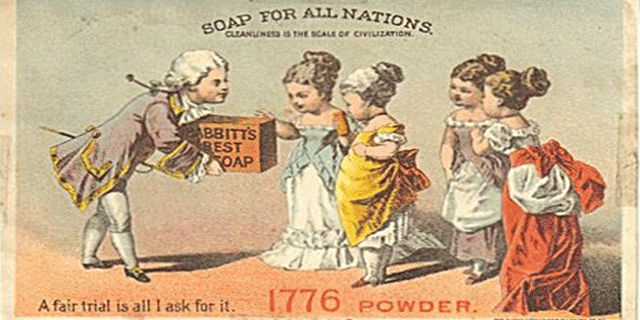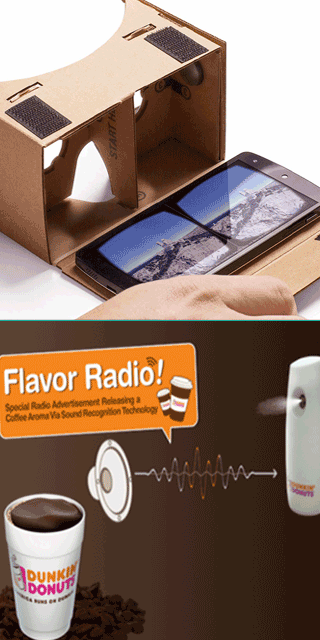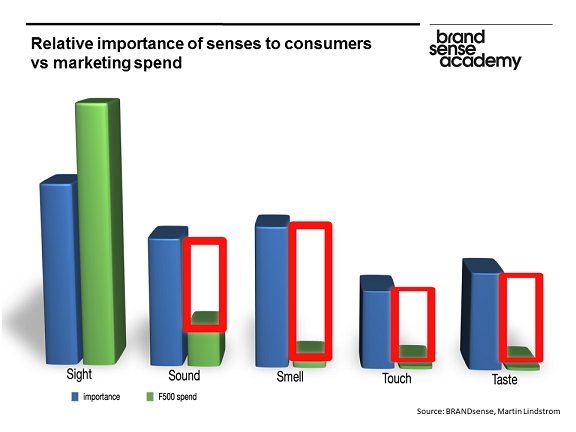Multi-sensory "brand sampling"
2015’s answer to ‘product sampling’ is to offer consumers a completely immersive and extrasensory brand experience through their communications.
With Benjamin T Babbit, a 19th century soap manufacturer, widely believed to be the first to offer free samples of his products to the public, product sampling is clearly nothing new to the world of marketing.


Since then, brands have used sampling as a means of igniting consumer interest in their products, establishing familiarity and trust of the brand and ultimately creating loyal customers.
Giving consumers the opportunity to taste, smell, hear or feel the product has proven time and time again to generate sales. A study carried out by Arbitron and Edison Media Research reported 1/3rd of customers who try a sample will buy the sampled product in the same shopping trip. There were also strong indications that product sampling leads to a trusting and loyal relationship between consumer and brand, with 58% saying they would buy the product again.
The benefits of product sampling may well be old news among the marketing community; however the concept behind it has never been more relevant than it is to the modern consumer.
Today’s world is one of hyper-consumerism and excess choice in every aspect of our lives. The continuous bombardment of consumers with visual advertising stimuli both online and offline has lead to us adopting a kind of subconscious selective attention process. Research carried out by sensory marketing ambassador Simon Harrop on the subject found that, disturbingly, the average western child will be subjected to more than 2 million TV ads by the age of 16. It’s therefore no surprise that our brains have become hugely efficient at simply ignoring the vast majority of visuals we come in to contact with each day. We know what doesn’t interest us, and it is filtered out of our consideration, and our lives, in a millisecond.
The mass-market, TV advertising ‘talk at’ model is no longer effective. The boom of the digital age has only enhanced this overload, with communications online still mostly visual.
This is coupled with a growing phenomenon that, through our hyper-connectivity, we are feeling more and more disconnected from everything else. In a world where virtual reality increasingly trumps real life experience and interaction; we crave something that will grab our distracted attention and make us feel real again.
There is all to play for, then, for brands who can find a way to connect with their consumers in new and interesting ways. Creating experiences which engage the so frequently forgotten senses like sound, smell, touch and taste is at the forefront of this revolution.
It’s all in the science. Visual stimuli are processed by the rational part of our brain, the cortex, while competing senses like touch, sound, smell and taste bypass this area and trigger an instinctual response-which directly affects our feelings and emotions.
Emotional response is invaluable for creating a long-lasting relationship between brand and consumer. We know this. Yet research carried out by Martin Lindstrom on Fortune 500 companies (seen below) found that on average 83% of marketing budgets goes toward visual communication (green). This is despite the fact other senses were found to be equally important to consumers in their relationship with brands (blue).

As with all things revolutionary, first come the early-adopters. The innovators. Among others, we are seeing big brands like Nivea, Dunkin’ Donuts and Google dive head-first into this new way of thinking with their extrasensory marketing activities. Nivea turned a print ad in Brazil into wearable technology and won the Mobile Grand Prix for their child-tracking wrist watch, which users tore out from their magazine campaign and hooked up to an app to stop their little ones from straying too far on the beach (have a look below at the resulting tv ad).
Google offered a completely immersive and interactive virtual reality with the launch of their very affordable DIY cardboard headset, which allowed users to simulate climbing inside their smartphone’s. Brands such as River Island got on board with the homemade gadget to offer their consumers virtual fashion during 2015 London Fashion week.
Meanwhile, Dunkin’ Donuts targeted consumer noses, integrating traditional radio ads with new scented technology; releasing the aroma of coffee and donuts into commuter buses every time their ad was played. Helm bank in Colombia has even become the world’s first multi-sensory bank, with a signature fragrance (steadily released throughout stores), flavour (in branded bottled water and sweets) and an interior design driven by colours, textures and shapes all congruent with core brand values.
With the evolution of technology, sensory branding has never been so sophisticated or exciting as these examples demonstrate. The way that brands can utilize sound, smell, taste and more interactive visuals in the experiences they create for their consumers is increasingly innovative and engaging. Failure to embrace this opportunity wholeheartedly will leave laggard brands behind; fighting to keep their head above water in order to be seen in a sea of ignored 2D visual drivel.
References; http://www.marketingcharts.com/traditional/product-sampling-boosts-awareness-sales-purchase-propensity-asap-6211/
http://www.simonharrop.com/blog/




